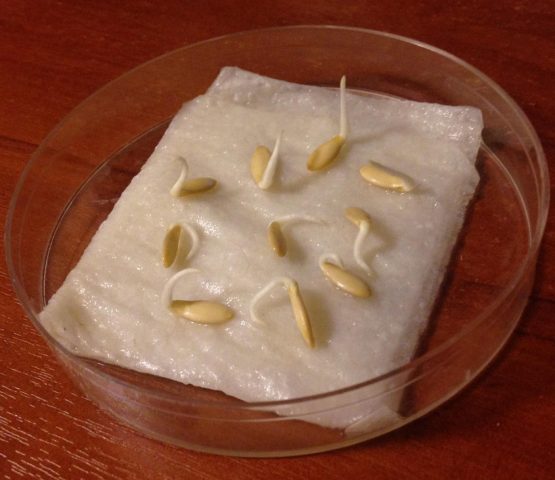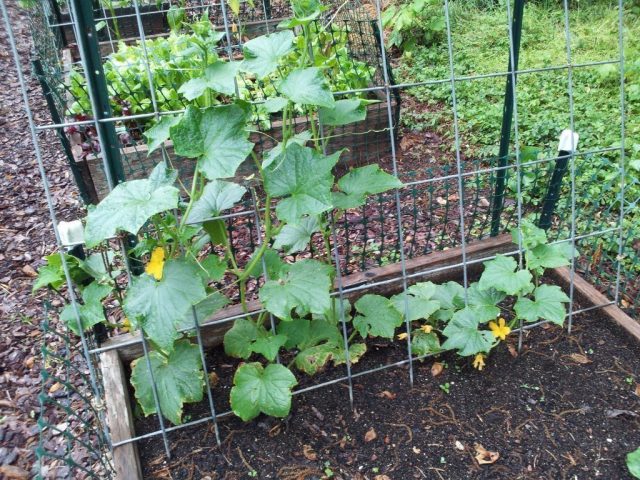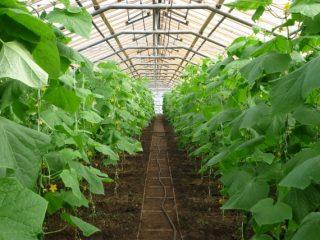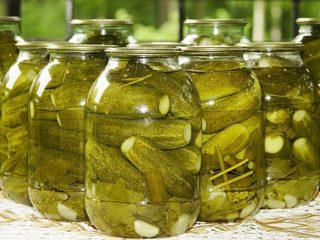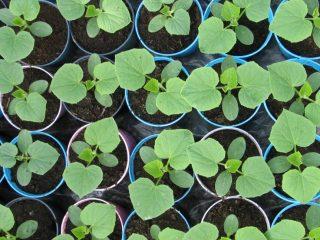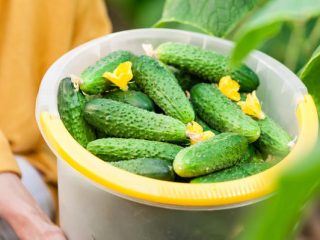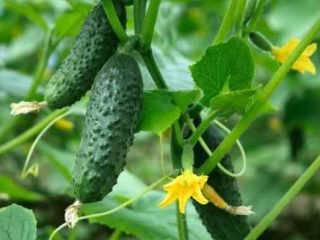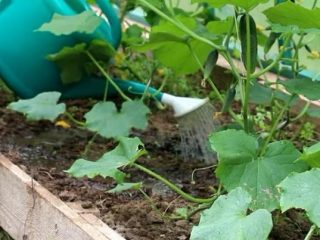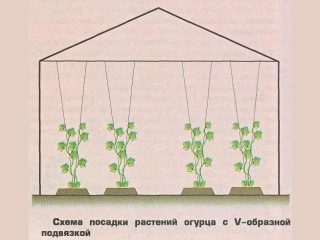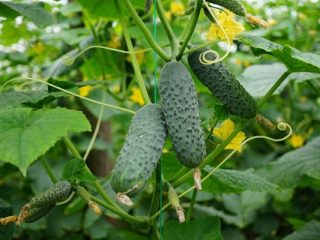Content
Most owners of their own land plots prefer to independently grow all kinds of vegetable crops, among which cucumbers are the most common. The species created as a result of genetic crossing called Hector is extremely popular among various varieties. Descriptions and reviews of the Hector F1 cucumber indicate the productivity and stability of this variety.
Description of the cucumber variety Hector
Hector is an early-ripening variety of bush-shaped cucumbers with a female way of developing the physiological processes of flowering, which is recommended for cultivation in open space. The vegetable crop grows in the form of a low-growing bush, about 75 - 85 cm high. This variety of cucumbers has practically no branched inflorescences. The Hector F1 variety is weather-resistant, so it can be used by gardeners in different climates. The flowers of the plant are pollinated by bees.
The oval fruits of this cucumber variety have a wrinkled, bumpy surface.The thin outer shell is covered with a noticeable waxy coating with protruding soft light-colored spines. The size of the fruit with a diameter of about 3 cm reaches a length of 10 - 12 cm, weight is on average 100 g.
Taste qualities of cucumbers
Hector cucumbers have excellent taste characteristics, making them popular among vegetable growers. The dense, juicy pulp of the fruit of the variety is distinguished by a fresh herbaceous aroma with a sweetish aftertaste. The watery vegetable has excellent refreshing qualities. The seeds of unripe fruits have a delicate consistency. Hector cucumbers do not have a bitter taste and have a spicy cucumber smell.
Pros and cons of the Hector cucumber variety
The process of growing cucumbers of the Hector F1 variety by land owners has characteristic pros and cons.
Positive aspects of using this variety of vegetable:
- rapid ripening - 30 days after planting the seedlings in the ground;
- a large percentage of the resulting products, which involves collecting 5 - 6 kg of cucumbers from a piece of land with an area of 1 m²;
- resistance to specific diseases;
- frost resistance, relating to low limits of temperature reduction;
- preservation of the taste of fruits during transportation;
- admissibility of use for canning.
Among the disadvantages of the Hector variety, the following are noted:
- annual purchase of seeds for planting, due to the production of this variety of cucumbers by crossing plant crops;
- possible thickening of the skin of cucumbers due to untimely harvesting, affecting the taste properties;
- Fruiting occurs only in the first 3 weeks.
Optimal growing conditions
Hector cucumber seeds are sown in open ground, as well as in greenhouse conditions. The most suitable time for this is the end of April, May, when the air temperature rises to 15 - 20 °C. Among the optimal requirements for growing a crop in order to obtain a rich harvest are:
- use for planting fertile sandy areas of land with high water permeability and good absorption of solar heat;
- soil enrichment before sowing with peat, minerals, humus, compost;
- location of seeds in the soil at a depth of less than 4 - 5 cm.
Growing cucumbers Hector F1
After planting Hector cucumber seeds, it is necessary to constantly care for the sown area of land. First of all, you should follow the rules of optimal watering, which involve systematic irrigation with maximum soil moisture during the fruiting period.
In addition, it is recommended to carry out systematic weeding, as well as remove yellowed, dried leaves and vines of the plant.
An additional valuable feed for the soil is organic mulch, which also prevents the active growth of weeds in the cultivated area.
Direct planting in open ground
When planting cucumbers in the soil, you must adhere to certain recommendations:
- 15 - 20 days before sowing the crop, the soil should be dug up and enriched with fertilizers;
- place cucumber seeds in prepared loosened soil at a depth of 2 - 3 cm;
- to speed up the fruiting of cucumbers, use pre-grown seedlings;
- sow vegetables in the form of garden beds;
- do not use land on which pumpkin plants were previously grown.
Growing by seedlings
For growing Hector F1 cucumbers, light sandy soils are most preferable. It is not advisable to plant vegetables on soils with high acidity, as well as on clay infertile areas. Soil loosening is carried out by farmers to achieve better permeability of valuable substances and complete moisture in the future.
The crop is grown by seedlings in late March or early April. Fertile soil at room temperature is poured into small containers (ordinary plastic cups with holes cut at the bottom can be used for this purpose to allow excess moisture to escape). Cucumber seeds are sown in them at a depth of 1 cm, sprinkled with soil, carefully watered with water, covered with film and set aside in a warm, bright place for further germination of the plant. To speed up the process, the seeds can be placed in a cloth soaked in water for 2 - 3 days in advance.
When several green leaves appear, the seedlings are transferred to prepared open ground.
Watering and fertilizing
The volume of water used to optimally moisten the soil when growing Hector cucumbers depends on the territorial-climatic environment and the natural characteristics of the land. In any case, for high-quality, uniform irrigation of the cultivated crop, it is better to use a drip irrigation system.
It is recommended to enrich the soil with useful mineral fertilizers without nitrate nitrogen - in combination with organic additives.
Formation
Pinching of the central stem of Hector cucumbers is carried out at the request of the landowner. In this case, 4 - 5 lateral lower shoots and the top of the main shoot are removed - if its length exceeds 70 cm.
Hector is a hybrid cucumber variety with a female flowering type. Therefore, you don’t have to resort to shaping the plant, but simply place it on a trellis net.
Protection from diseases and pests
Hector is rarely exposed to various viruses and other cucumber diseases. Most often it becomes infected with ashtray. If appropriate measures are not taken to eliminate the fungus in a timely manner, the plant may die completely.
To protect against crop damage by pests, certain preventive measures are taken:
- control over the implementation of favorable growing conditions;
- timely irrigation of soil in optimal quantities;
- providing protective cover on days with unfavorable weather conditions;
- moistening the soil with non-cold water.
If infection by viruses or fungi has already occurred, the plant along with the fruits should be sprayed with special means, such as “Fundazol”, “Topaz”, “Skor”. For the same purposes, use a solution of soda or laundry soap in a proportion of 5 g of product per 1 liter of water or whey diluted with water 1:3.
Productivity
Hector F1 cucumbers have good reviews; in the photo you can see the external characteristics of the variety.From a garden bed with an area of 1 m², approximately 4 kg of ripened fruits are obtained, used as a vitamin nutrient in raw form, as well as a tasty canned product.
Cucumbers are harvested once, 2-3 days in advance, to avoid thickening the skin of the vegetable and deteriorating its taste. The length of Hector's fruits can vary in the range of 7 - 11 cm.
Conclusion
Having considered the description and reviews of the Hector F1 cucumber, many gardeners will want to try growing it themselves. It should be taken into account that the appearance and taste of the crop are determined by the fertility of the soil, a well-chosen place for planting, good timely care, and exposure to weather conditions.
Taking into account that Hector cucumbers are early-ripening varieties capable of producing a rich, tasty harvest, resistant to viral and fungal infections, they are a fairly popular product, which is used for consumption both raw and canned.

